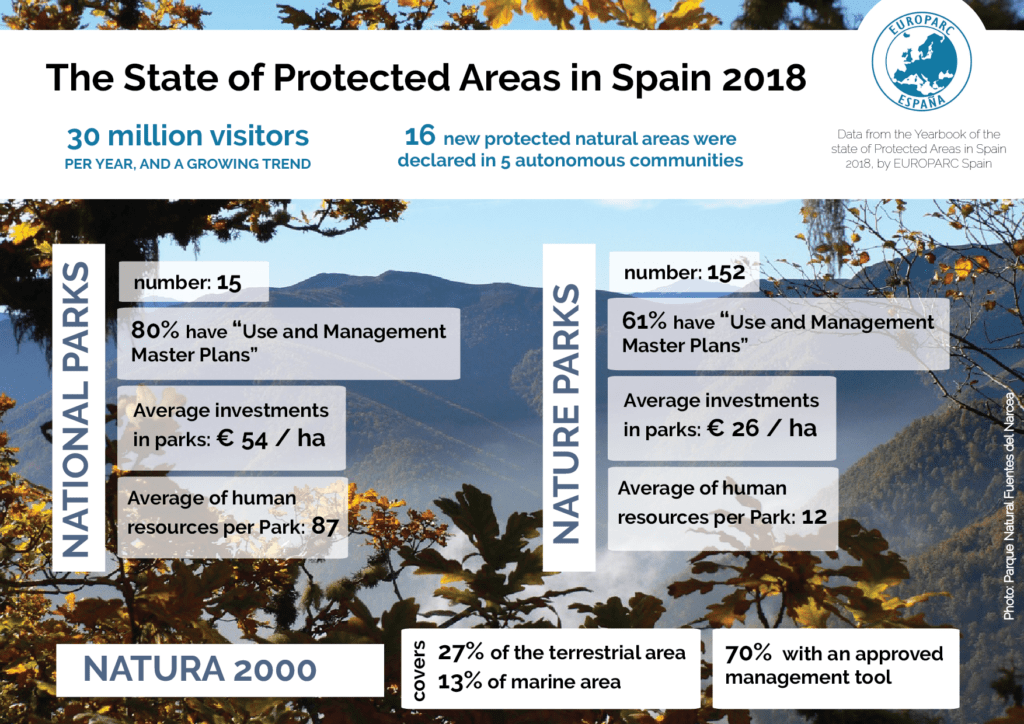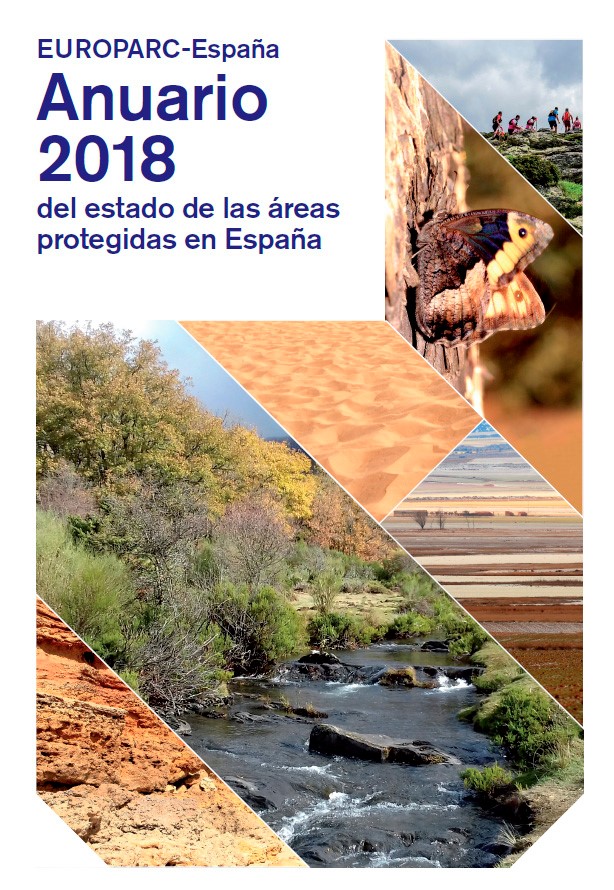The state of Protected Areas in Spain – Yearbook 2018 by EUROPARC Spain
To celebrate the World Environment Day, EUROPARC Spain launched the 2018 Yearbook of the state of Protected Areas in Spain. Following EUROPARC’s Spain commitment of “having a living observatory of protected areas in the Spanish State”, in 1999 they implemented a systematic methodology to collect annually information on the:
- Protected terrestrial and marine area coverage
- Current status of planning of protected natural areas and the Network Natura 2000
- Evolution of the economic and human resources dedicated to the management of protected areas,
- Management effectiveness
- Examples of new governance models
- Evolution of visits to national and natural parks
- Contribution to the welfare of the society of these territories.
- Perspectives on connectivity and adaptation to climate change
The Yearbook comes out just one year before the balance of the 20 Aichi Targets assumed a decade ago by the Convention on Biological Diversity, that aimed to halt biodiversity loss on the planet, ensure the sustainable use of natural resources and equitably distribute the benefits of conservation. The review shows that Spain will partially fulfill some of the commitments in terms of quantitative targets, specifically those set out in Target 11.

In Spain, over 27% of the protected terrestrial area and about 13% of marine protected waters are included in the Natura 2000 network,
making Spain with one of the European countries with the largest Natura 2000 coverage. In quantitative terms and on a global scale, there is a positive evolution. Currently, 238,563 protected areas are covered covering 20 million km2, equivalent to 14.9% of the land area. With regard to marine protection, it would have reached 7%, mainly in the exclusive economic zone (up to 200 nautical miles, with 16.8% and only 1.2% beyond 200 nautical miles from the coast).
However, Target 11 also poses complex challenges. In addition to designating places with the implications of previous studies, social-political commitment, they must be managed effectively and equitably. And needs to be connected and integrated into the territory. Evaluating these aspects requires necessarily deepen the analysis of the means (legal, material, economic and human resources) and procedures governing the management of such sites.
From numbers… to management effectiveness
Significant progress has also been made in the management of protected areas, but, nevertheless, despite the overcoming of the most difficult years of the economic crisis, the average investment in the parks continues to fall, which does not comply with the increase in the number of visitors.
Investment in protected areas and its efficient management are strategic in an ecological transition horizon, the fight against climate change and education and enjoyment of the values of nature. With an average investment in parks continuing to decrease € 54 / ha in national parks (the lowest registered) and € 26 / ha in natural parks (values similar to 2010), EUROPARC Spain, claims that budgetary allocations of protected areas need to be improved, so that they can adequately meet their very important functions.
For the promotion and strengthening of protected areas as preferential territories for the conservation of nature and sustainable development, in harmony with the United Nations Sustainable Development Goals (ODS).

The state of Spanish protected areas in a nutshell:
1) The 27% of the protected land area has been exceeded, included in the Natura 2000 Network, and almost 13% of the marine surface has been protected. Spain has complied with the international commitment to declare at least 17% of land and 10% of the marine surface.
2) There are 15 national parks and 152 natural parks declared in Spain. There are also 291 nature reserves, 342 natural monuments, 57 protected landscapes, and more than 800 spaces, usually of small size, designated with other figures developed by the autonomous communities.
3) Between 2017 and 2018, 16 new protected natural areas have been declared in five autonomous communities. Furthermore, the large marine protected area of the Mediterranean Cetacean Migration Corridor has been also declared.
4) Among the new areas protected by international schemes, the Ponga Biosphere Reserve has been declared: Spain is the country that hosts the highest number Biosphere Reserves, with a total number of 49. Additionally, a new RAMSAR site, a new Geopark and a new UNESCO natural site have been declared.
5) Significant progress has been made in planning: 80% of national parks and 61% of natural parks have PRUGs (Use and Management Master Plans). 70% of the Natura 2000 spaces have an approved management tool.
6) Average investments in parks continue a decreasing trend: € 54 / ha in national parks (the lowest registered) and € 26 / ha in natural parks (values similar to 2010).
7) The human resources dedicated to the management of the parks follow a similar pattern since 2012: an average of 87 people in national parks and 12 in natural parks.
8) The estimated number of visitors in national and natural parks exceeds 30 million, with an increasing trend in national parks.
9) 43% of the agreements of land stewardship, a tool for involving society in conservation, have been implemented totally or partially in spaces adhered to the Network Natura 2000, covering a surface of more than 265,000 hectares.
10) The State Strategy for green infrastructure, connectivity and ecological restoration has been released to the public and it is still in the process of formal approval. Additionally, several autonomous communities have approved strategic documents.
